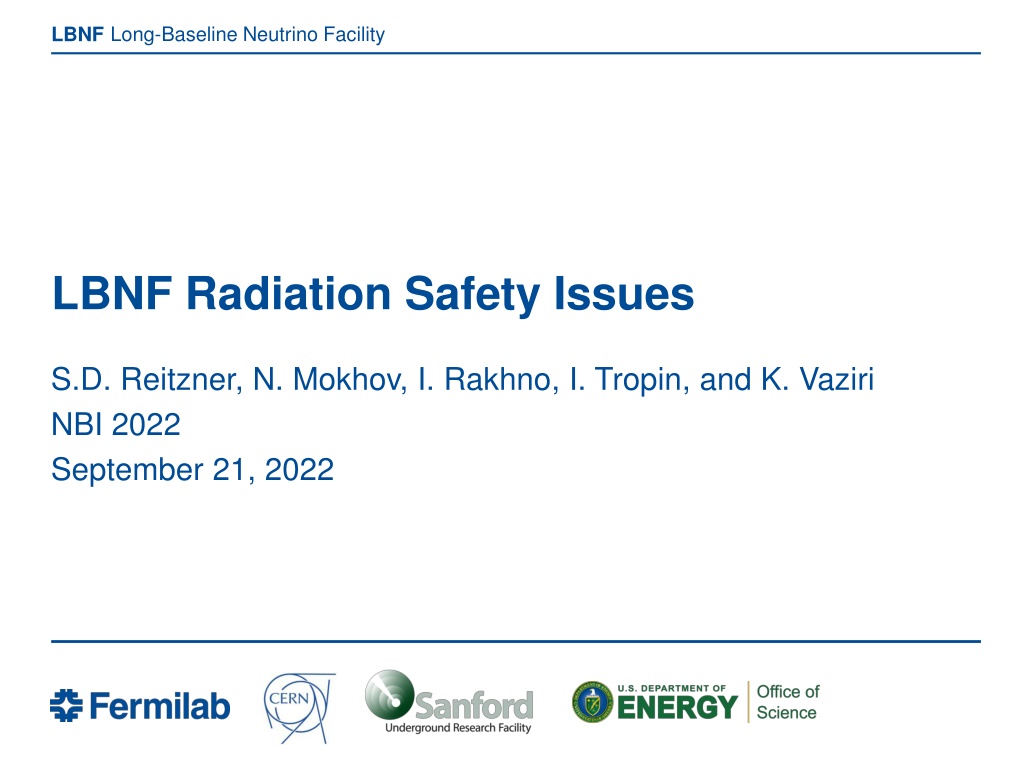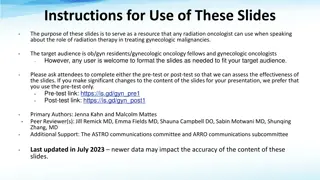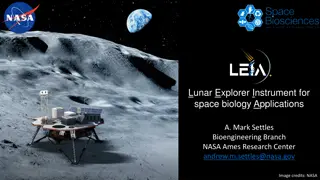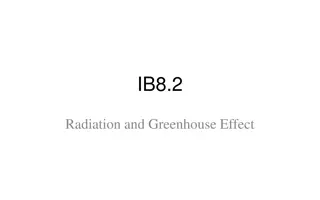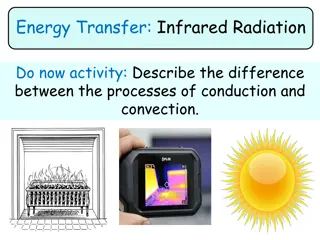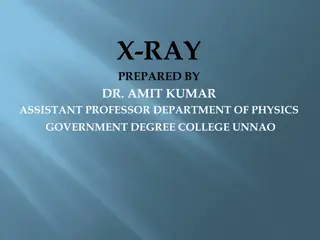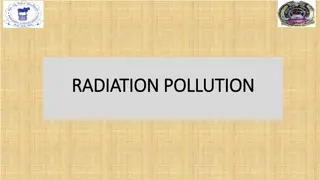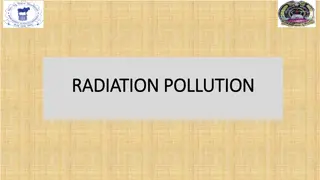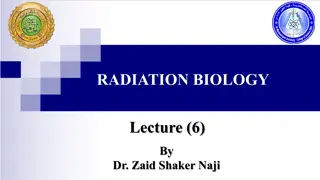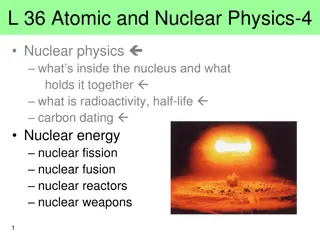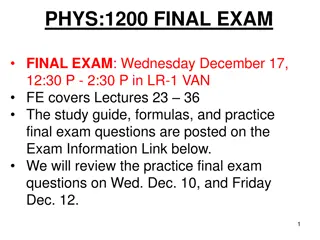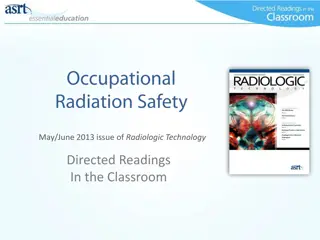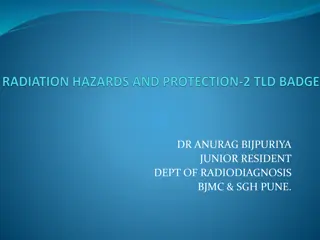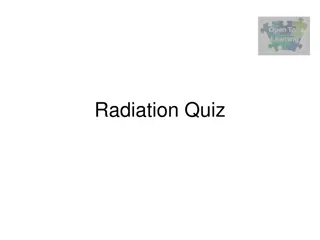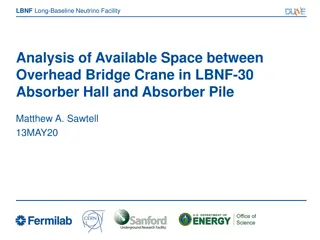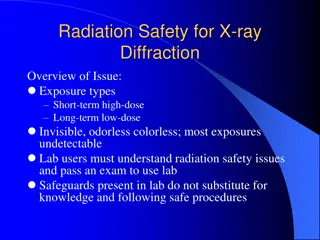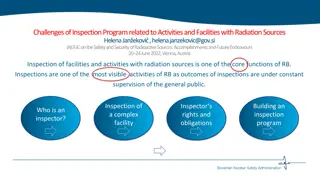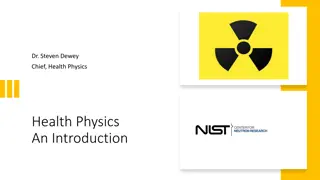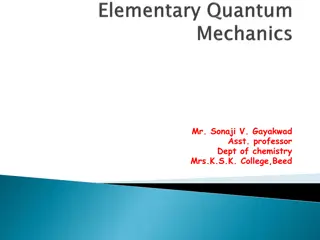LBNF Radiation Safety Issues Overview
The Long-Baseline Neutrino Facility (LBNF) addresses radiation safety issues through various components such as prompt radiation, residual radiation, activated air release, and ground water protection. Detailed modeling parameters using MARS for radiological safeguards are discussed, along with prompt dose levels at different locations within the facility. The safety measures ensure protection for both radiation and non-radiation workers during operation.
Download Presentation

Please find below an Image/Link to download the presentation.
The content on the website is provided AS IS for your information and personal use only. It may not be sold, licensed, or shared on other websites without obtaining consent from the author.If you encounter any issues during the download, it is possible that the publisher has removed the file from their server.
You are allowed to download the files provided on this website for personal or commercial use, subject to the condition that they are used lawfully. All files are the property of their respective owners.
The content on the website is provided AS IS for your information and personal use only. It may not be sold, licensed, or shared on other websites without obtaining consent from the author.
E N D
Presentation Transcript
Long-Baseline Neutrino Facility LBNF LBNF Radiation Safety Issues S.D. Reitzner, N. Mokhov, I. Rakhno, I. Tropin, and K. Vaziri NBI 2022 September 21, 2022
Introduction Beamline Overview Radiation transport modeling parameters Prompt radiation Residual radiation Ground water protection Activated air release Conclusion 09.21.22 S.D. Reitzner, et. al | LBNF Radiation Safety Issues 2 LBNF
LBNF Beamline Components Neutrino Beam to SURF, SD Absorber Complex (LBNF-30) Target Complex (LBNF-20) Primary Beamline Enclosure Decay Region Primary Beam Service Building (LBNF-5) Fermilab Main Injector Tunnel 09.21.22 S.D. Reitzner, et. al | LBNF Radiation Safety Issues 3 LBNF
Radiation Transport Modeling Parameters Radiological safeguards designs based on 2.4 MW operation 120 GeV protons @ 1.5 1014 p / 1.2 s 56% duty factor Model radiation transport using MARS - 2.2 m target for target hall calculations - 1.5 m target for decay pipe and absorber 09.21.22 S.D. Reitzner, et al | LBNF Radiation Safety Issues 4 LBNF
LBNF MARS Model Absorber Hall Target Station Target Hall Decay Pipe 09.21.22 S.D. Reitzner, et. al | LBNF Radiation Safety Issues 5 LBNF
Prompt Dose 7 ft thick ceiling 5 ft thick walls 10 mrem/year from entire lab at site boundary. 166 mrem/hr 0.25 mrem/hr for rad worker 50 rem/hr for non rad workers Neutrons/GeV/cm2/s mrem/hr No access during operation. Energy (GeV) 09.21.22 S.D. Reitzner, et. al | LBNF Radiation Safety Issues 6 LBNF
Prompt Dose at Nitrogen Handling Room Level Y = 0 m 2.5 mrem/hr Nitrogen handling room (NHR) Morgue Pretarget mrem/hr 53 mrem/hr 86 mrem/hr No access in pretarget or NHR during beam on 09.21.22 S.D. Reitzner, et. al | LBNF Radiation Safety Issues 7 LBNF
Prompt Dose at Battlement Level Access Corridor Y = 4.9 m 54 rem/hr Power Supply Radioactivate Water (RAW) N2 fill Borated poly cover mrem/hr Work Cell Battlement Rad worker access to support rooms except RAW y = 4.9 m 09.21.22 S.D. Reitzner, et. al | LBNF Radiation Safety Issues 8 LBNF
Residual Dose <200 mrem/hr top of shield pile 150 mrem/hr max on concrete blocks 230 mrem/hr max top of steel 100-d irr/4-hr cooling mrem/hr 200 rem/hr max t-blocks 800 rem/hr max cooling panels 09.21.22 S.D. Reitzner, et. al | LBNF Radiation Safety Issues 9 LBNF
Remote Handling and Storage Work cell is designed for 4000 rad/hr on contact object. 2000 R/hr activity estimated for Horn B or Horn A and target Work cell and morgue located in target hall. Target hall will be shielded enough to handle unshielded moves. 09.21.22 S.D. Reitzner, et. al | LBNF Radiation Safety Issues 10 LBNF
Ground Water Protection for Target Hall Federal surface water limits: 3H < 2600 pCi/mL - 22Na < 16 pCi/mL Potential transmission to ground water via support piles. - - Shield to meet groundwater limit. Groundwater limit below limit of detection 3H <1 pCi/mL - 22Na <0.04 pCi/mL Underdrain system to reduce buildup. - stars cm-3s-1 09.21.22 S.D. Reitzner, et. al | LBNF Radiation Safety Issues 11 LBNF
Ground Water Protection Absorber Hall Shield to meet groundwater limit. Steel kern downstream to protect from muons - 170 length - 10 diameter Barrier to prevent tritium diffusing from shielding into environment. Monitoring wells to be used to detect any contamination. 09.21.22 S.D. Reitzner, et. al | LBNF Radiation Safety Issues 12 LBNF
Air Activation Air emission permit of 0.1 mrem/year annual sitewide release (EPA) - LBNF annual release goal to be < 30 rem/year to the public. Nitrogen cooling for the target hall and decay pipe will maintain LBNF air releases within budget. Maintain negative pressure in areas of activated air. 09.21.22 S.D. Reitzner, et. al | LBNF Radiation Safety Issues 13 LBNF
Air Release Path 09.21.22 S.D. Reitzner, et. al | LBNF Radiation Safety Issues 14 LBNF
Total Air Releases 3H 11C 13N 15O 41Ar Exit (Ci/yr) 7.08 10-2 2.37 10-4 1.59 10-12 2.23 10-70 Absorber Hall 2.54 1.32 10-4 5.09 10-31 NHR 1.03 1.41 1.36 2.42 102 1.4 101 8.60 10-5 Target Hall 1.16 1.98 2.78 101 1.68 10-1 4.21 10-12 Morgue 1.16 1.29 7.78 10-3 8.77 10-9 9.59 10-1 Primary Encl 1.16 5.53 41Ar from RAW 0.49% FNAL Site Limit 0.96 Ci/yr Tritium from other sources 3H Source Activity (Ci/yr) Total release: 30.66% of FNAL Site Limit Target Pile 540 28.25% of FNAL Site Limit Decay Pipe 152 Absorber Pile 156 Tgt He Cooling 0.015 09.21.22 S.D. Reitzner, et. al | LBNF Radiation Safety Issues 15 LBNF
Wait Time Access Due to Activated Air No access to area until air activity below 0.1 DAC after beam off. DAC: Derived Air Concentration DAC = ??? - Ci = concentration of ith isotope Location Wait Time Absorber Hall 6 hrs NHR 45 min Target Hall 1.5 hrs Primary Encl 1.5 hrs ?? - CRi = concentration of ith isotope which gives 5000 mrem effective dose from a 2000 hr exposure. 09.21.22 S.D. Reitzner, et. al | LBNF Radiation Safety Issues 16 LBNF
Conclusion Appropriate selection of shielding to maintain prompt dose below limits set by FNAL policy. - Model for 120 GeV, 2.4 MW operation. Shielding and underdrains will be used to maintain concentration of radioactive isotopes below regulatory limits for surface and ground water. Morgue and work cell in target hall to allow for unshielded moves. Use of nitrogen for cooling and long transit times in ventilation to maintain activated air releases below regulatory limit. 09.21.22 S.D. Reitzner, et. al | LBNF Radiation Safety Issues 17 LBNF
